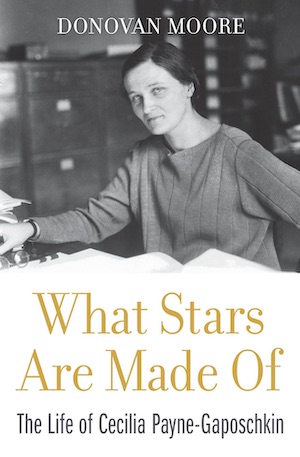By Jay M. Pasachoff
When I went to meet the “Chairman” of the Astronomy Department as a Harvard “freshman” in 1959, I was awed to be greeted by a tall, impressive, chain-smoking, British-accented woman, Professor Cecilia Payne-Gaposchkin. So that was my calibration of normal. How was I to know that she was then the only female on the Harvard Faculty of Arts and Sciences (minor caveat below)?
It was with great interest that I read Harvard University Press’ new biography of “Mrs. G.,” as she was known, especially since the Harvard president of 100 years ago said that there should not be a female teaching on their faculty. Donovan Moore may have started his biography off slowly, with interesting but perhaps overly elaborate discussions of Cecilia Payne’s schooling, and the structure of college for females at Cambridge University about 100 years ago, but—perhaps as any good book should do—had me crying at the end, with the quotation (twice) of The New York Times from June 21, 1956, that “Harvard University announced today the appointment of Dr. Cecilia Payne-Gaposchkin as Professor of Astronomy. She is the first woman to attain full professorship at Harvard through regular faculty promotion.”
What did CPG do that made her one of the top astronomers of the century? (She didn’t like it when someone said “top woman astronomer.”) Everybody had thought for hundreds of years that the stars were made of the same stuff as our Earth, a uniform composition, an idea known as uniformitarianism. So when young Cecilia, sprung from England to a Harvard College Observatory fellowship, applied the new physics she had been learning about to a collection of photographs of spectra of hundreds of thousands of stars in the “plate stacks,” and realized that there was thousands of times more hydrogen than iron, and that the stars are mainly hydrogen and helium—in hindsight it seems reasonable that such a conclusion needed more than just a young person’s PhD thesis. I learned from this biography about the astropolitics involved, and how Harlow Shapley, the Harvard College Observatory director, advised her to humor Henry Norris Russell, the Princeton professor who was unofficial dean of American astronomy. He advised her, basically, to formally adopt Russell’s misgivings. So the thesis does conclude that hydrogen is dominant in stars but then states that the conclusion is “almost certainly not real.” It took a few more years and measurements of different types by Russell himself and by another young astronomer, Donald Menzel, before Cecilia’s conclusion was accepted—and it has stood the test of time.
We learn many times throughout the book how Cecilia had suffered from limitations placed on women trying to do science, even when the science was top notch. And maybe she would have been Shapley’s successor as director herself had she been male. But she was asked if she would mind if Menzel, a rival, was appointed to Harvard; he became director in 1952. When he saw her salary, he had it doubled, and then he soon arranged for her to receive the professorial appointment, decades after it had begun to be deserved. Now her oil portrait hangs in the faculty room at Harvard’s University Hall in the middle of Harvard Yard.
Moore, not a trained scientist, got a lot of coaching in the science and its significance from astronomer and historian of science Owen Gingerich at Harvard, historian of science David DeVorkin at the Smithsonian Air and Space Museum, and polymath astronomer Virginia Trimble at the University of California, Irvine. He had the benefit of CPG’s daughter Katherine Haramundanis’ book that incorporated autobiographical notes, The Dyer’s Hand: An Autobiography in Cecilia Payne-Gaposchkin: An Autobiography and Other Recollections (1984), including also Trimble’s chapter. Further, he had material from a Festschrift The Starry Universe: The Cecilia Payne-Gaposchkin Centenary (2000) and a chapter by Vera C. Rubin (after whom Congress has recently named a new U.S. National Observatory) in Out of the Shadows: The Contributions of Twentieth-Century Women to Physics (2006). Not noticed in the many pages of endnotes is a dual biography of Cecilia Payne-Gaposchkin and her husband, Sergei Gaposchkin: Portrait of a Binary: The Lives of Cecilia Payne and Sergei Gaposchkin (2014) by Sylvia Boyd. The book under review even merited a back-of-the-dust-jacket quote of endorsement from Billie Jean King.
Oh, after her decades of chain smoking (cited many times in the book, so it wasn’t just my recollection), she died of lung cancer, though not until 1979.
There is a nice selection of photos of CPG throughout from all her young ages.
I recommend the book to all readers, though if you want to get to the Harvard and the science part, save the childhood and England part for second.
Astronomer and author Jay M. Pasachoff (ΦBK, Williams College) is the director of the Hopkins Observatory and Field Memorial Professor of Astronomy at Williams College. He is a visitor in the Carnegie Observatories. Williams College is home to the Gamma of Massachusetts chapter of Phi Beta Kappa.




